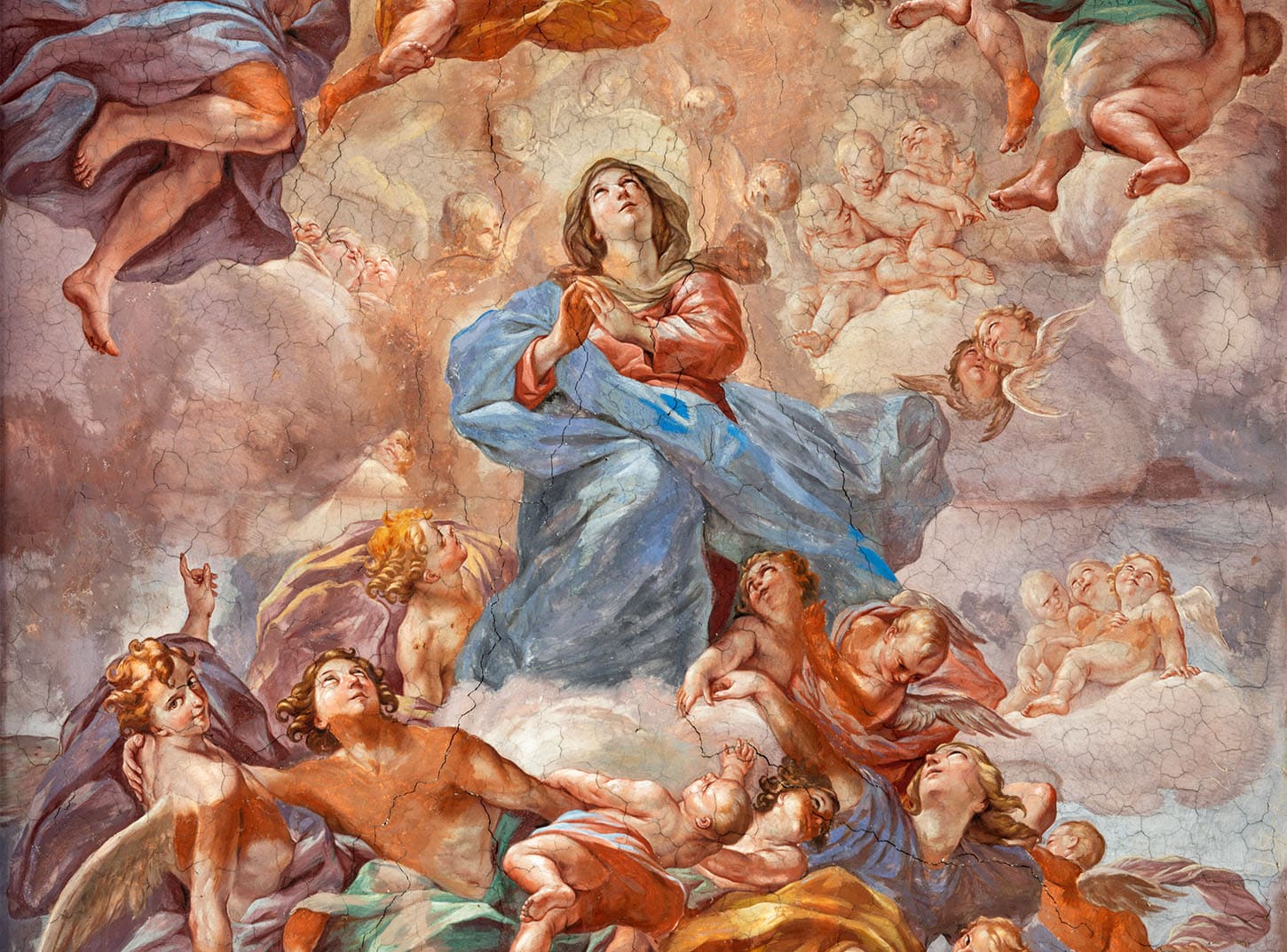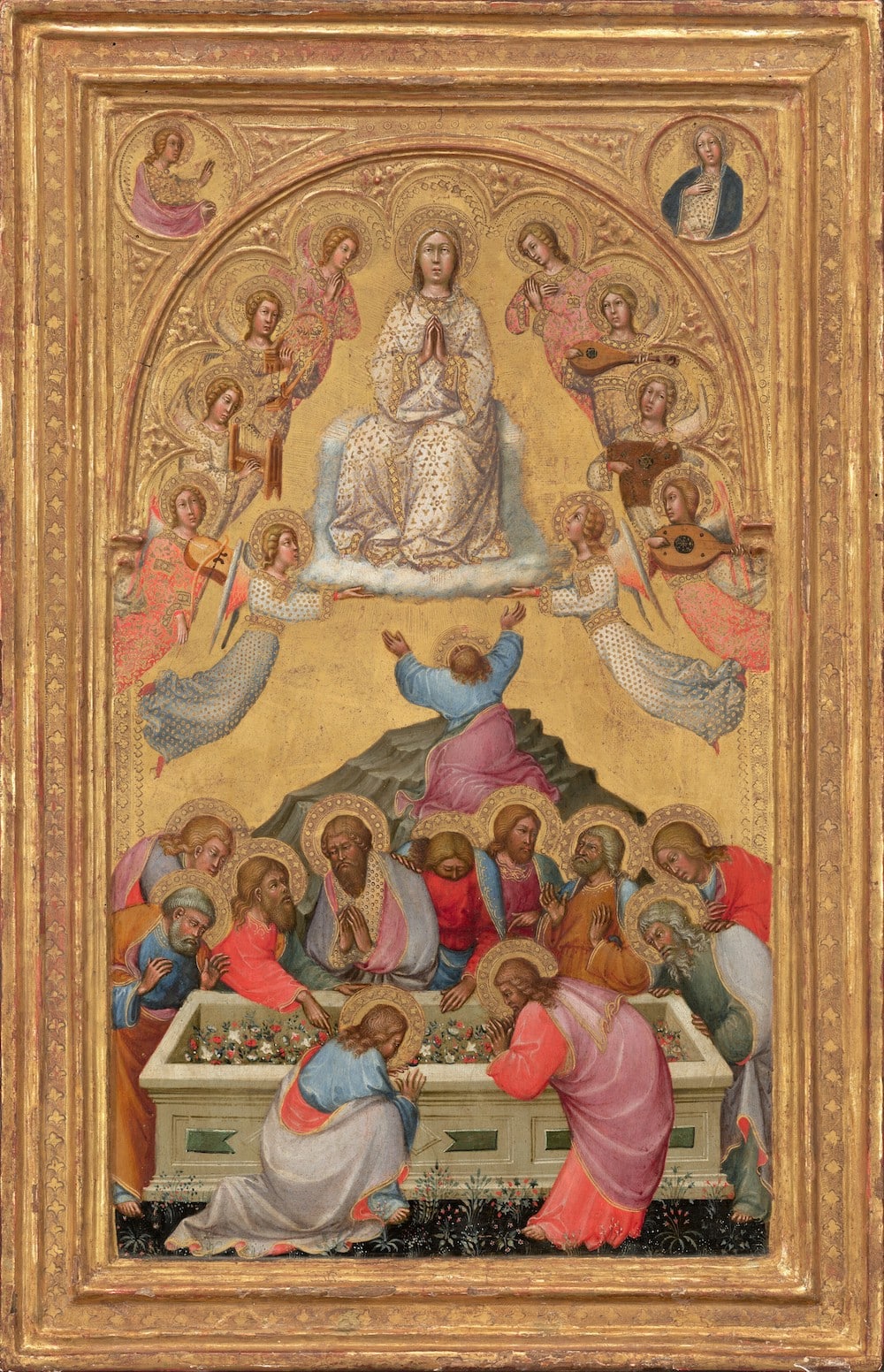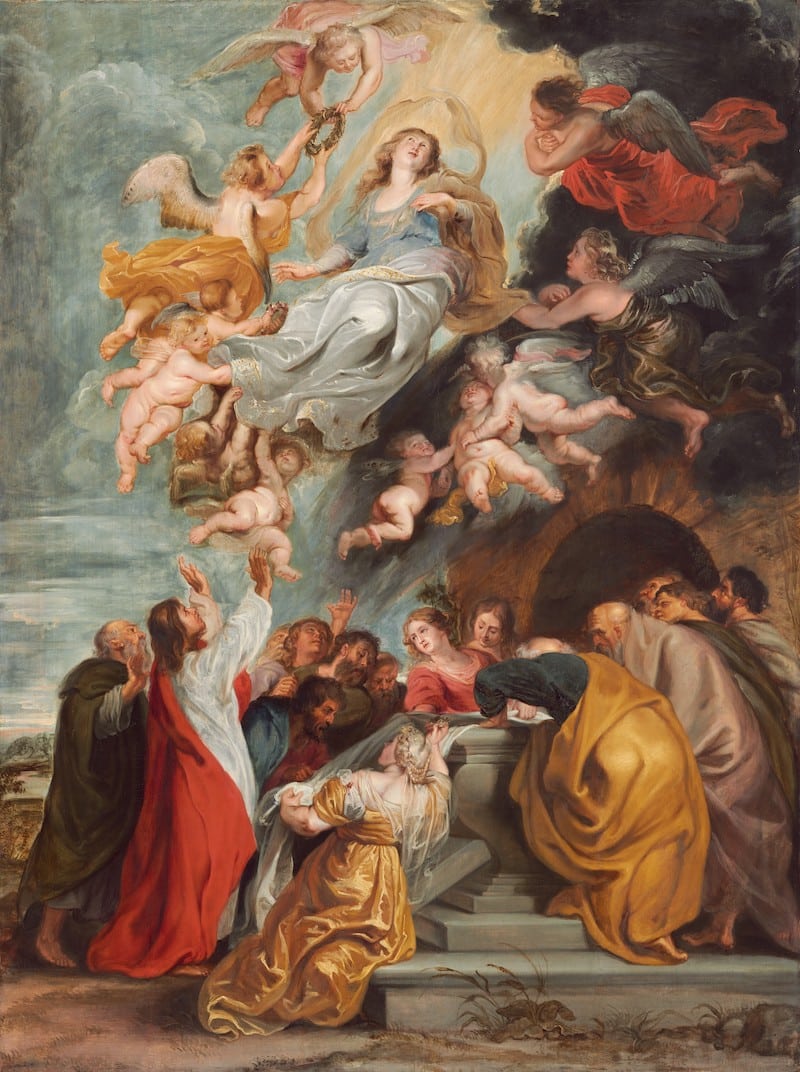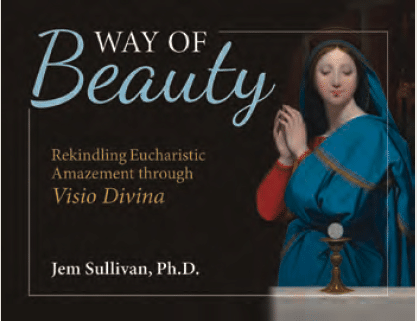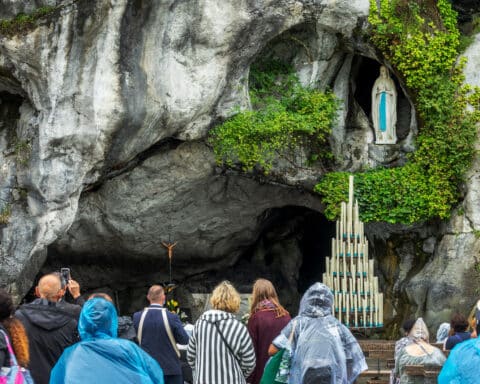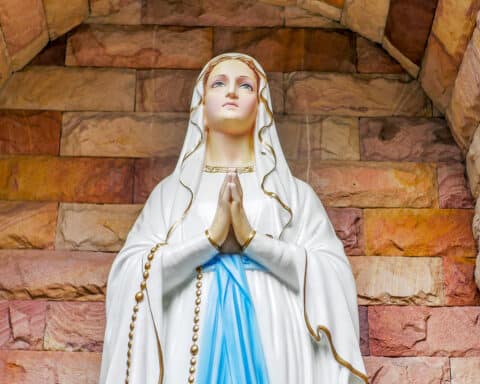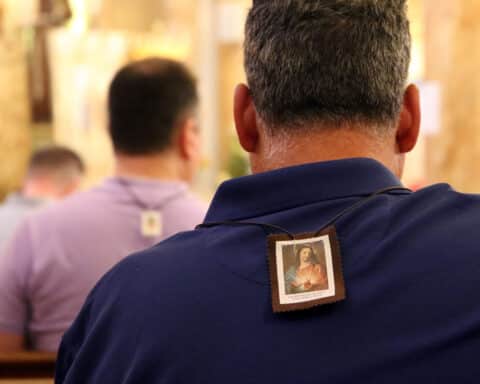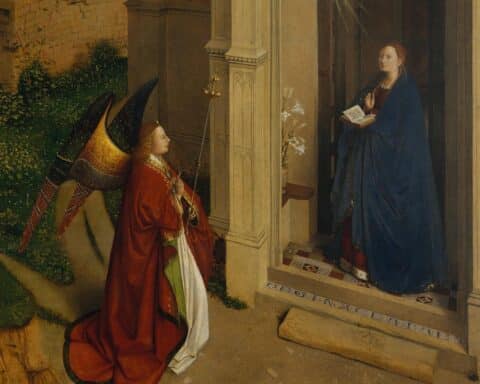“Almighty ever-living God, who assumed the Immaculate Virgin Mary, the Mother of your Son, body and soul into heavenly glory, grant, we pray, that always attentive to the things that are above, we may merit to be sharers of her glory. Through our Lord Jesus Christ, your Son, who lives and reigns with you in the unity of the Holy Spirit, God, for ever and ever.”
This stirring collect prayer begins our sharing in the Church’s celebration of the solemnity of the Assumption of the Blessed Virgin Mary. We are invited to gaze on the wonder of Mary’s assumption, body and soul into heavenly glory, as the path of our sanctification here on earth and the hope of our future glory in heaven with her resurrected son, Jesus. The solemnity of the Assumption of Mary is about the renewal of our body and mind here and now, and our deep-seated hope for peace and future communion with God who so desires and invites our friendship.
It is a gift of faith to celebrate God’s loving work of assuming Mary into the divine family of the Blessed Trinity, the saints, and the angels. Mary invites us, her spiritual children, to nothing less than a share in her glory. And artists down through the centuries have conveyed Mary’s invitation through masterpieces of sacred art depicting her assumption. Through a visio divina with artistic masterpieces, we walk with Mary on the path of beauty as she sheds light on her assumption and its transformative meaning for our life. Adapting the ancient monastic practice of lectio divina, a prayerful slow reading and reflection on sacred Scripture, visio divina invites a slow, prayerful and contemplative seeing with eyes of faith. We allow Mary, our spiritual mother, to guide us on a pilgrimage of beauty with three exquisite masterpieces of sacred art that bring to life in color, line and form, the meaning of her glorious assumption. For Mary’s assumption carries within it the hope of our radical transformation as disciples of her divine son, Jesus.
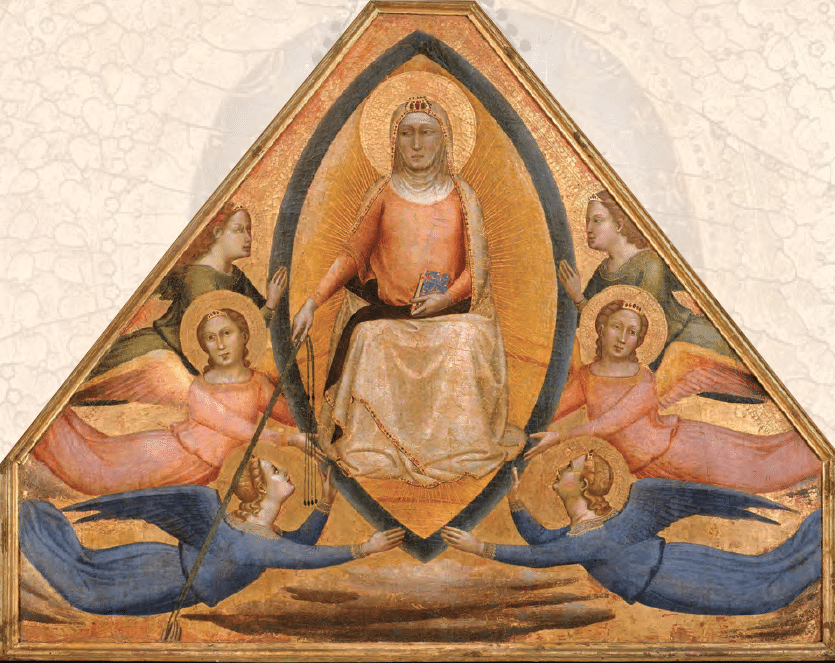
‘THE ASSUMPTION OF THE VIRGIN’
Bernardo Daddi, c. 1337-39
Metropolitan Museum of Art
Mary, Woman Graced by God
An early 14th-century Italian altarpiece panel evokes popular devotion to belief in Mary’s assumption into heaven. Painted in vibrant colors and set against a brilliant gold leaf background, this altarpiece panel is said to be designed by Bernardo Daddi and completed by gifted artists in his workshop in Florence. Daddi, a student of Giotto, considered the father of the Italian Renaissance, adds a refined beauty and grace to his work. The panel was once part of a much larger altarpiece in the Cathedral of Prato, an ancient church in region of Tuscany. The cathedral is home to a revered devotional treasure, a relic of Mary’s belt also known as the Girdle of Thomas, or Sacra Cintola, a symbol of Mary’s motherhood of Jesus. According to the Golden Legend, a medieval collection of devotional accounts, Mary gifted her belt to the doubting St. Thomas to confirm the apostles’ faith in Jesus’ resurrection and her assumption to heaven.
At the center of the composition, the artist paints the delicate seated figure of the Blessed Virgin Mary on a bank of clouds. She is enclosed in a mandorla, an almond shaped halo that envelops her entire body from which rays of golden light radiate. A host of haloed angels, dressed in vibrant hues of red and blue, float effortlessly in animated movement across the scene as they hold up the mandorla. A jeweled crown on Mary’s head indicates her unique role as Queen of Heaven. In her left hand, Mary holds the Scriptures, a visual reminder that she is the one who bore the Word of God into the world. Mary continues to teach the Church, and each one of us, how to hear and to live in the power of God’s word.
From Mary’s right hand, a long belt extends downward to the bottom of the panel where we see only the hand of St. Thomas who receives the sacred relic. Mary’s belt, a visual reminder of her divine motherhood, is now gifted to Thomas, and to all believers, so that faith in her divine son, Jesus, may grow into discipleship and witness to the world. Two angels, dressed in deep green, stand close to Mary as they gaze on the Mother of God. Their prayerful reverence invites our contemplation of Mary’s assumption as a sacred moment for a graced encounter with God’s loving hand of friendship.
‘THE ASSUMPTION OF THE VIRGIN WITH THE ARCHANGEL GABRIEL AND THE VIRGIN OF THE ANNUNCIATION’
Paolo di Giovanni Fei, c. 1400-05
National Gallery of Art, Washington, D.C.
Mary, Woman of Faith
This exquisite painting in tempera on wood was completed around 1400 by the Italian painter, Paolo di Giovanni di Fei, a gifted artist from the city of Siena. He was influenced by Duccio, the master artist of Siena, who painted one of the first images of Mary’s assumption in his majestic Masta altarpiece. Most likely, this panel decorated a private chapel and was a vital part of the devotional life of the household of its patron.
We see the Blessed Virgin Mary being assumed into heaven on a seat of clouds held aloft by a host of angels who are each enclosed in golden haloes. The angelic hosts indicate that this sacred moment is a work of God, not of human hands and beyond human imagination. Dressed in ornate robes studded with gold accents, the angels carry a variety of string and wind instruments. Such early Renaissance paintings offer important visual records of the history of musical instruments in use at the time. They also emphasize that the eternal praise of God in the form of sublime music forms part of the heavenly worship into which Mary is now being assumed.
In the upper corners, the scene is framed by two round panels with the Archangel Gabriel and Mary at the Annunciation. These two sacred events — namely, the Annunciation and the Assumption — frame Mary’s earthly life.
What sets this scene apart is the artist’s interest in conveying the reaction of the disciples, who gather intently around Mary’s tomb, now filled with fragrant petals and flowers of every color and size. The artist carefully paints each of the figures with animated gestures and lively faces filled with awe and wonder at this sacred moment in Mary’s life. And their response is offered for our imitation as we give thanks to God. With their backs to us, two apostles kneel before the tomb of Mary with their hands joined in prayer. Their perspective is meant to be our perspective, as we are called to share in the awe and wonder of the moment.
According to medieval legend, Thomas, who doubted the resurrection of Jesus, prayed to Mary for greater faith through a sign of her assumption to heaven. And the Mother of God is said to have given him the belt that held her robes together, a symbol of her pure maternity as the mother of Jesus. So, here we see, once again, the dramatic gesture of Thomas who kneels at the top of the small hill below Mary. Thomas throws wide open his arms and raises his head back in wonder and gratitude to Mary for this gift of faith.
Throughout her entire earthly life, Mary points to her divine son, Jesus. As she is assumed into heaven, Mary moves closer to the eternal presence of God to lead us closer to Jesus. In celebrating her feast, we take the hand of the Blessed Virgin Mary in faith and entrust ourselves to her maternal care and protection to walk the path of discipleship with Jesus.
‘THE ASSUMPTION OF THE VIRGIN’
Studio of Sir Peter Paul Rubens, c. mid 1620s
National Gallery of Art, Washington, D.C.
Mary, Queen of Heaven
This masterpiece image of the assumption of Mary, Mother of God, from the National Gallery of Art is thought to be an early 17th-century replica of a sketch by Sir Peter Paul Rubens, the master Baroque painter of the 17th century. Rubens was known and admired for his dramatic large-scale paintings depicting mythological, biblical and religious scenes with strong sense of movement and intense color. This replica sketch is a good example of his unique and masterful style.
Every element in the scene appears to move upward in dramatic movement toward heaven. Our eyes move around the painting as angels and biblical figures float effortless across the scene. The artist infuses each figure with lively movement and grace filled energy as they experience a radiant vision of Mary’s assumption into heaven. And here again, we see Mary being assumed by God into heaven as she is carried aloft by many angels. The Mother of God is clothed in flowing robes of silken blue and white, indicating her purity and maternity. Two angels hold a wreath of flowers as they prepare to crown her Queen of Heaven. Directly below the angels is the empty tomb of Mary, surrounded by a group of animated biblical figures and apostles.
Included in the scene are the three women of the Gospels named Mary, one of whom holds the silken cloth of Mary’s shroud. Behind them, St. John the Evangelist and St. Thomas stretch out their arms to heaven in faith and in praise of God.
In this heavenly vision, the eyes of all focus on heaven. Through their eyes, we direct our gaze heavenward as we contemplate Mary’s assumption as a reminder of our final destiny to be with God for all eternity. There, we hope to fulfil the divine purpose for which we were created, which is to praise the Father, the Son and the Holy Spirit in the company of Mary, Queen of Heaven and Queen of the angels and the Communion of Saints.
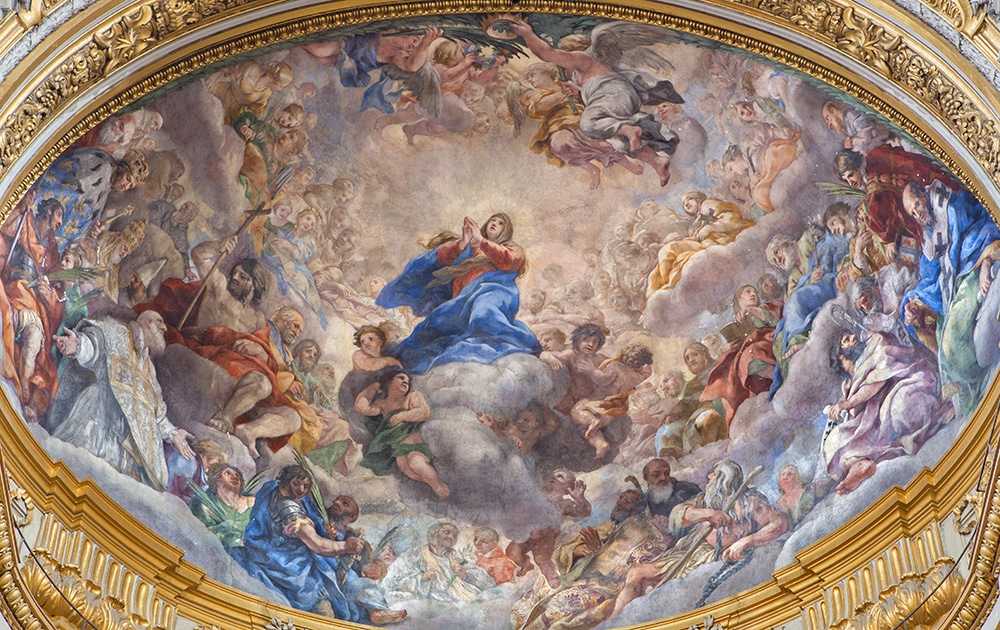
Understanding the importance of Mary’s assumption
As these masterpieces of sacred art attest, well before 1950 when Pope Pius XII defined Mary’s assumption as a matter of Catholic faith, belief in her bodily assumption was part of popular devotion for centuries. One finds belief in Mary’s bodily assumption, for instance, in the writings of early Church Fathers like Melito of Sardis and John Damascene. In the Middle Ages, devotion to Mary’s assumption took the form of interest in the location and event of her passing, or transitus, from earthly to eternal life. In Eastern Christianity, this feast is celebrated as the Dormition of Mary, one of the stages of “sleep” as she passes from death to resurrection to her glorious assumption into heaven.
Over centuries, theological reflection and popular devotion rested on the conviction that Mary’s unique role as the Mother of God meant that God preserved her from the stain of original sin from the first moment of her conception to the end of her earthly life. From the Latin verb assumere, (“to take to oneself”), God took Mary to himself to be united with Jesus, her son and the Holy Spirit, who overshadowed her at the Annunciation.
Mary’s sinlessness means that from her conception, birth, earthly life and for all eternity, God preserved from the effects of sin and death Mary, the woman he chose to bear his divine son Jesus. This is a singular privilege God gives to Mary. And her assumption into heaven, body and soul, flows from God’s generous preserving of her sinless body that was alone graced to bear Jesus into the world. No other person was so closely united with Jesus in his earthly life than his mother. In a different and parallel way, just as Jesus conquered death in his resurrection and ascension to heaven, Mary, by God’s particular grace, overcame the sting of sin and death as she was assumed, body and soul, into heaven for all eternity.
Belief defined
The link between Jesus’ resurrection and ascension, Mary’s assumption and our own spiritual transformation is noted by the Catechism of the Catholic Church in clear, profound words:
“‘Finally, the Immaculate Virgin, preserved free from all stain of original sin, when the course of her earthly life was finished, was taken up body and soul into heavenly glory, and exalted by the Lord as Queen over all things, so that she might be the more fully conformed to her Son, the Lord of lords and conqueror of sin and death.’ The Assumption of the Blessed Virgin is a singular participation in her Son’s Resurrection and an anticipation of the resurrection of all Christians” (CCC, No. 966).
It is our spiritual regeneration then, our rising from the effects of sin and death, that Mary wishes to share with us as she is assumed into heaven. For as the Catechism notes, “The most Blessed Virgin Mary, when the course of her earthly life was completed, was taken up body and soul into the glory of heaven, where she already shares in the glory of her Son’s Resurrection, anticipating the resurrection of all members of his Body” (CCC, No. 974).
| ‘Way of Beauty’ |
|---|
|
We are created for beauty, the visible form of truth and goodness. The experience of beauty awakens our spiritual senses and prepares us for a new way of seeing the world. Through its beauty and spiritual power, the Eucharist provides us with the opportunity to experience a deeply personal transformation of life. Jem Sullivan’s new book, “Way of Beauty: Rekindling Eucharistic Amazement through Visio Divina” (OSV, $18.95), aims to help you discover, or rediscover, a sense of Eucharistic amazement through the beauty of sacred art depicting the theology, history and spirituality of the Mass. This beautiful book also introduces the practice of visio divina, focusing on the Eucharist through 12 masterpieces of sacred art. Alongside each work of art, you will find prayers of the Mass, passages from sacred Scripture and the Catechism of the Catholic Church, and a guided reflection. With each reflection, you’ll be led on a Eucharistic pilgrimage of beauty to encounter how the desire and promise of Jesus to be with his disciples always continues today in the gift and mystery of the Eucharist. |
Catholic belief in the assumption of Mary, celebrated and developed over centuries, was formally defined by Pope Pius XII in his 1950 apostolic letter Munificentissimus Deus, which stated: “Now God has willed that the Blessed Virgin Mary should be exempted from this general rule of death. She, by an entirely unique privilege, completely overcame sin by her Immaculate Conception, and as a result was not subject to the law of remaining in the corruption of the grave, and she did not have to wait until the end of time for the redemption of her body.”
“What the Catholic faith believes about Mary is based on what it believes about Christ, and what it teaches about Mary illumines in turn its faith in Christ,” notes the Catechism (No. 487). From ancient times, the Blessed Virgin Mary has been honored with titles of praise and with special devotion, different from the adoration that is given alone to God who is Father, Son and Holy Spirit. The Marian feasts of the Church are special moments on our pilgrim journeys of faith to turn to the Mother of God as we seek her maternal protection, love and guidance.
As the Mass for the solemnity of the Assumption of Mary concludes, the Church prays these words: “Having received the sacrament of salvation, we ask you to grant, O Lord, that, through the intercession of the Blessed Virgin Mary, whom you assumed into heaven, we may be brought to the glory of the Resurrection. Through Christ our Lord. Amen.”
As we sing the praises of Mary at her assumption, may we stand in awe of what God did for Mary and what God, through Mary’s maternal love and desire, can and will do for each one of us in renewing and transfiguring our bodies in the radiant light of divine love and mercy.

